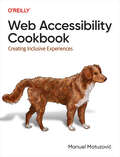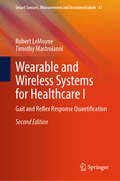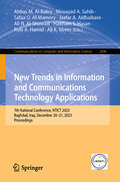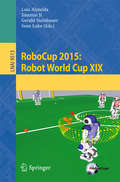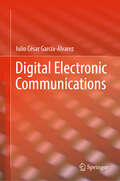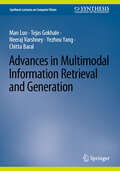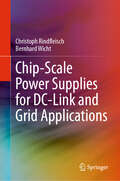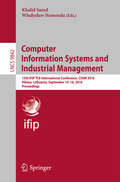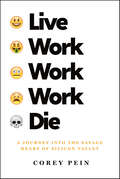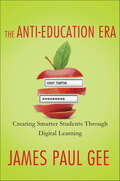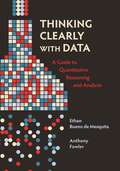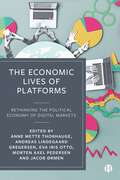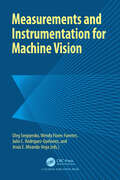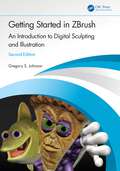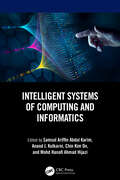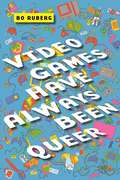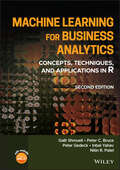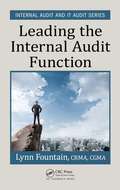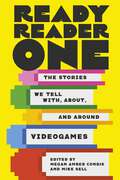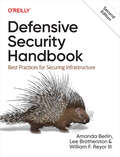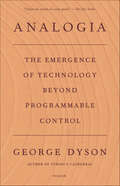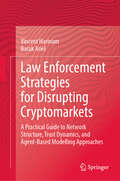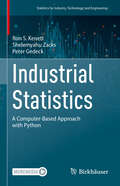- Table View
- List View
Web Accessibility Cookbook
by Manuel MatuzovicFrontend developers have to consider many things: browser compatibility, usability, performance, scalability, SEO, and other best practices. But the most fundamental aspect of creating websites is one that often falls short: accessibility. Accessibility is the cornerstone of any website, and if a website is inaccessible, users won't be able to interact with it, obtain information, sign up for services, or buy products.The Web Accessibility Cookbook provides you with dozens of recipes to help you avoid these failures. You'll learn how to build common components, such as main navigation, filters, and dialogs, in an accessible manner. Each recipe not only explains how to build things but also why. Author Manuel Matuzovic provides the knowledge you need to create your own accessible components and address your users' varying needs, abilities, and preferences.With this practical guide, you will:Learn how to build websites that feature inclusive frontendsDiscover the common obstacles website users face every dayUnderstand how your decisions impact usersLearn how to build accessible frontends step-by-stepWrite high-quality markup and CSSEvaluate the accessibility of frontend components
Deep Learning Techniques for Automation and Industrial Applications
by Abhishek Kumar Pramod Singh Rathore Sachin Ahuja Anupam Baliyan Srinivasa Rao Burri Ajay KhuntetaThis book provides state-of-the-art approaches to deep learning in areas of detection and prediction, as well as future framework development, building service systems and analytical aspects in which artificial neural networks, fuzzy logic, genetic algorithms, and hybrid mechanisms are used. Deep learning algorithms and techniques are found to be useful in various areas, such as automatic machine translation, automatic handwriting generation, visual recognition, fraud detection, and detecting developmental delays in children. “Deep Learning Techniques for Automation and Industrial Applications” presents a concise introduction to the recent advances in this field of artificial intelligence (AI). The broad-ranging discussion covers the algorithms and applications in AI, reasoning, machine learning, neural networks, reinforcement learning, and their applications in various domains like agriculture, manufacturing, and healthcare. Applying deep learning techniques or algorithms successfully in these areas requires a concerted effort, fostering integrative research between experts from diverse disciplines from data science to visualization. This book provides state-of-the-art approaches to deep learning covering detection and prediction, as well as future framework development, building service systems, and analytical aspects. For all these topics, various approaches to deep learning, such as artificial neural networks, fuzzy logic, genetic algorithms, and hybrid mechanisms, are explained. Audience The book will be useful to researchers and industry engineers working in information technology, data analytics network security, and manufacturing. Graduate and upper-level undergraduate students in advanced modeling and simulation courses will find this book very useful.
Wearable and Wireless Systems for Healthcare I: Gait and Reflex Response Quantification (Smart Sensors, Measurement and Instrumentation #47)
by Timothy Mastroianni Robert LeMoyneThis book is the second edition of the one originally published in 2017. The original publication features the discovery of numerous novel applications for the use of smartphones and portable media devices for the quantification of gait, reflex response, and an assortment of other concepts that constitute first-in-the-world applications for these devices. Since the first edition, numerous evolutions involving the domain of wearable and wireless systems for healthcare have transpired warranting the publication of the second edition. This volume covers wearable and wireless systems for healthcare that are far more oriented to the unique requirements of the biomedical domain. The paradigm-shifting new wearables have been successfully applied to gait analysis, homebound therapy, and quantifiable exercise. Additionally, the confluence of wearable and wireless systems for healthcare with deep learning and neuromorphic applications for classification is addressed. The authors expect that these significant developments make this book valuable for all readers.
New Trends in Information and Communications Technology Applications: 7th National Conference, NTICT 2023, Baghdad, Iraq, December 20–21, 2023, Proceedings (Communications in Computer and Information Science #2096)
by Abbas M. Al-Bakry Safaa O. Al-Mamory Mouayad A. Sahib Haitham S. Hasan Jaafar A. Aldhaibani Ali N. Al-Shuwaili Rula A. Hamid Ali K. IdreesThis book constitutes the refereed proceedings of the 7th National Conference on New Trends in Information and Communications Technology Applications, NTICT 2023, held in Baghdad, Iraq, during December 20–21, 2023. The 28 full papers included in this book were carefully reviewed and selected from 92 submissions. They were organized in topical sections as follows: artificial intelligence and machine learning; and computer networks.
RoboCup 2015: Robot World Cup XIX (Lecture Notes in Computer Science #9513)
by Luis Almeida Jianmin Ji Gerald Steinbauer Sean LukeThis book is the Proceedings of the 19th Annual RoboCup International Symposium, held in Hefei, China, in July 2015.The book contains 20 papers presented at the Symposium, carefully selected from 39 submissions. Additionally the book contains 11 champion team papers and one paper from the Workshop on Benchmarking Service Robots. The papers present current research in robotics, artificial intelligence, computer vision, multiagent systems, simulation, and other areas.
Digital Electronic Communications
by Julio César García-ÁlvarezThis book provides the basic concepts of electronic digital communication, applied to professional practice in communications engineering. The book begins with basic concepts of information theory and explains the need for digital communications, continuing with the basic schemes of digital communication prior to multiplexing, which applies to current digital communication networks, such as LTE, 5G and 6G. The book is intended for researchers, professionals, and second-year students of electrical engineering, electronics or telecommunications. It can also be useful to students in computer science, engineering physics or other disciplines who develop projects involving electronic communication systems.
Advances in Multimodal Information Retrieval and Generation (Synthesis Lectures on Computer Vision)
by Chitta Baral Man Luo Tejas Gokhale Neeraj Varshney Yezhou YangThis book provides an extensive examination of state-of-the-art methods in multimodal retrieval, generation, and the pioneering field of retrieval-augmented generation. The work is rooted in the domain of Transformer-based models, exploring the complexities of blending and interpreting the intricate connections between text and images. The authors present cutting-edge theories, methodologies, and frameworks dedicated to multimodal retrieval and generation, aiming to furnish readers with a comprehensive understanding of the current state and future prospects of multimodal AI. As such, the book is a crucial resource for anyone interested in delving into the intricacies of multimodal retrieval and generation. Serving as a bridge to mastering and leveraging advanced AI technologies in this field, the book is designed for students, researchers, practitioners, and AI aficionados alike, offering the tools needed to expand the horizons of what can be achieved in multimodal artificial intelligence.
Chip-Scale Power Supplies for DC-Link and Grid Applications
by Bernhard Wicht Christoph RindfleischThis book is a comprehensive single-source on the design of chip-scale high-voltage power supplies for low-power DC-link and grid applications. It is written in handbook style with systematic guidelines and includes implementation examples. The authors cover the full range, from technology fundamentals to circuit implementation details. The book includes guidelines for the application-specific selection of the converter topology, design guidelines for the inductive components, and a detailed description of low-power optimized control approaches and subcircuits. The authors also include guidelines for the selection and design of high-voltage on-chip power switches and for the reduction of parasitic effects such as capacitive losses.
Computer Information Systems and Industrial Management: 15th IFIP TC8 International Conference, CISIM 2016, Vilnius, Lithuania, September 14-16, 2016, Proceedings (Lecture Notes in Computer Science #9842)
by Khalid Saeed Władysław HomendaThis book constitutes the proceedings of the 15th IFIP TC8 International Conference on Computer Information Systems and Industrial Management, CISIM 2016, held in Vilnius, Lithuania, in September 2016. The 63 regular papers presented together with 1 inivted paper and 5 keynotes in this volume were carefully reviewed and selected from about 89 submissions. The main topics covered are rough set methods for big data analytics; images, visualization, classification; optimization, tuning; scheduling in manufacturing and other applications; algorithms; decisions; intelligent distributed systems; and biometrics, identification, security.
Live Work Work Work Die: A Journey into the Savage Heart of Silicon Valley
by Corey PeinA scathing, sardonic exploration of Silicon Valley tech culture, laying bare the greed, hubris, and retrograde politics of an industry that aspires to radically transform society for its own benefitAt the height of the startup boom, journalist Corey Pein set out for Silicon Valley with little more than a smartphone and his wits. His goal: to learn how such an overhyped industry could possibly sustain itself as long as it has. But to truly understand the delirious reality of the tech entrepreneurs, he knew he would have to inhabit that perspective—he would have to become an entrepreneur himself. Thus Pein begins his journey—skulking through gimmicky tech conferences, pitching his over-the-top business ideas to investors, and rooming with a succession of naive upstart programmers whose entire lives are managed by their employers—who work endlessly and obediently, never thinking to question their place in the system.In showing us this frantic world, Pein challenges the positive, feel-good self-image that the tech tycoons have crafted—as nerdy and benevolent creators of wealth and opportunity—revealing their self-justifying views and their insidious visions for the future. Vivid and incisive, Live Work Work Work Die is a troubling portrait of a self-obsessed industry bent on imposing its disturbing visions on the rest of us.
The Anti-Education Era: Creating Smarter Students through Digital Learning
by James Paul GeeOne of the first champions of the positive effects of gaming reveals the dark side of today's digital and social media Today's schools are eager to use the latest technology in the classroom, but rather than improving learning, the new e-media can just as easily narrow students' horizons. Education innovator James Paul Gee first documented the educational benefits of gaming a decade ago in his classic What Video Games Have to Teach Us About Learning and Literacy. Now, with digital and social media at the center of modern life, he issues an important warning that groundbreaking new technologies, far from revolutionizing schooling, can stymie the next generation's ability to resolve deep global challenges. The solution-and perhaps our children's future-lies in what Gee calls synchronized intelligence, a way of organizing people and their digital tools to solve problems, produce knowledge, and allow people to count and contribute. Gee explores important strategies and tools for today's parents, educators, and policy makers, including virtual worlds, artificial tutors, and ways to create collective intelligence where everyday people can solve hard problems. By harnessing the power of human creativity with interactional and technological sophistication we can finally overcome the limitations of today's failing educational system and solve problems in our high-risk global world. The Anti-Education Era is a powerful and important call to reshape digital learning, engage children in a meaningful educational experience, and bridge inequality.
Thinking Clearly with Data: A Guide to Quantitative Reasoning and Analysis
by Ethan Bueno de Mesquita Anthony FowlerAn engaging introduction to data science that emphasizes critical thinking over statistical techniquesAn introduction to data science or statistics shouldn’t involve proving complex theorems or memorizing obscure terms and formulas, but that is exactly what most introductory quantitative textbooks emphasize. In contrast, Thinking Clearly with Data focuses, first and foremost, on critical thinking and conceptual understanding in order to teach students how to be better consumers and analysts of the kinds of quantitative information and arguments that they will encounter throughout their lives.Among much else, the book teaches how to assess whether an observed relationship in data reflects a genuine relationship in the world and, if so, whether it is causal; how to make the most informative comparisons for answering questions; what questions to ask others who are making arguments using quantitative evidence; which statistics are particularly informative or misleading; how quantitative evidence should and shouldn’t influence decision-making; and how to make better decisions by using moral values as well as data. Filled with real-world examples, the book shows how its thinking tools apply to problems in a wide variety of subjects, including elections, civil conflict, crime, terrorism, financial crises, health care, sports, music, and space travel.Above all else, Thinking Clearly with Data demonstrates why, despite the many benefits of our data-driven age, data can never be a substitute for thinking.An ideal textbook for introductory quantitative methods courses in data science, statistics, political science, economics, psychology, sociology, public policy, and other fieldsIntroduces the basic toolkit of data analysis—including sampling, hypothesis testing, Bayesian inference, regression, experiments, instrumental variables, differences in differences, and regression discontinuityUses real-world examples and data from a wide variety of subjectsIncludes practice questions and data exercises
The Economic Lives of Platforms: Rethinking the Political Economy of Digital Markets
by Anne Mette Thorhauge, Andreas Lindegaard Gregersen, Eva Iris Otto, Jacob Ørmen and Morten Axel PedersenThis interdisciplinary collection rethinks the political economy of the digital market by asking what came before platforms and suggesting what might come after them. By unpacking the concept of ‘platform economies’ into locally embedded variations of digital markets, the book identifies what is new about contemporary platforms and what is characteristic of wider historical, social and economic currents. The diverse team of authors employ various analytical approaches, including in-depth ethnographic studies, and theoretical and analytical reconceptualizations of platforms and the industries they encompass.Tapping into current themes including the decolonisation of the internet, this book offers a timely assessment of the implications of emerging reconfigurations between technology, information, society and markets.
Measurements and Instrumentation for Machine Vision
by Jes Oleg Sergiyenko Wendy Flores-Fuentes Julio C. RodrA comprehensive reference book that addresses the field of machine vision and its significance in cyber-physical systems. It explores the multidisciplinary nature of machine vision, involving electronic and mechatronic devices, artificial intelligence algorithms, embedded systems, control systems, robotics, interconnectivity, data science, and cloud computing. The book aims to provide advanced students, early career researchers, and established scholars with state-of-the-art knowledge and novel content related to the implementation of machine vision in engineering, scientific knowledge, and technological innovation.The chapters of the book delve into various topics and applications within the realm of machine vision. They cover areas such as camera and inertial measurement unit calibration, technical vision systems for human detection, design and evaluation of support systems using neural networks, UV sensing in contemporary applications, fiber Bragg grating arrays for medical diagnosis, color model creation for terrain recognition by robots, navigation systems for aircraft, object classification in infrared images, feature selection for vehicle/non-vehicle classification, visualization of sedimentation in extreme conditions, quality estimation of tea using machine vision, image dataset augmentation techniques, machine vision for astronomical images, agricultural automation, occlusion-aware disparity-based visual servoing, machine learning approaches for single-photon imaging, and augmented visual inertial wheel odometry.Each chapter is a result of expert research and collaboration, reviewed by peers and consulted by the book's editorial board. The authors provide in-depth reviews of the state of the art and present novel proposals, contributing to the development and futurist trends in the field of machine vision."Measurements and Instrumentation for Machine Vision" serves as a valuable resource for researchers, students, and professionals seeking to explore and implement machine vision technologies in various domains, promoting sustainability, human-centered solutions, and global problem-solving.
Getting Started in ZBrush: An Introduction to Digital Sculpting and Illustration
by Gregory S. JohnsonGetting Started in ZBrush is a gentle introduction to ZBrush, today’s premier digital sculpting program. Beginning with the fundamentals of digital sculpting as well as a thorough introduction to the user interface, Getting Started in ZBrush will have you creating a variety of professional‑level 3D models in no time. More than just another button‑pushing manual, this comprehensive guide is packed with start‑to‑finish projects that ease you into the workflow of the program, while at the same time providing tips and tricks that will allow you to achieve certain tasks much more quickly. After progressing through the tutorials, you will be shown how to customize brushes, materials, scripts, and the interface so that you can utilize these tools to their full advantage.Special consideration is given to ZBrush’s integration plug‑ins with Maya and 3ds Max, allowing you to properly import and export your models in all programs. Texturing, painting, mapping, decimation, baking, and topology are also fully covered, so your Zbrush creations can come to life without sacrificing that high‑resolution look. Ease your way into this complex subject with this straight‑forward approach to Zbrush Perfect your technique with step‑by‑step tutorials that allow you to create high‑resolution models from start to finish Expand your knowledge by visiting the companion website, which features video demonstrations, project files, texture and model files, scripts, customized menus, brushes, and additional resources Written with the digital beginner in mind, this book will teach you all of the necessary information to begin working in ZBrush to create magnificent works of digital artwork! Through this book, ZBrush will empower you to be the digital artist you always wanted to be.
Intelligent Systems of Computing and Informatics
by Anand J. Kulkarni Chin Kim On Abdul Karim, Samsul Ariffin Hijazi, Mohd Hanafi AhmadSince 2011, the Fourth Industrial Revolution (IR4.0) has played a significant role in education, research, and industry. Data technologies have also evolved rapidly to cater to the rapidly growing size of the data as well as to enhance the security of the shared data through multiple resources and platforms.Intelligent Systems of Computing and Informatics aims to develop a new Intelligent Systems of Computing and Informatics (ISCI) to cater to the needs of industries in line with the United Nations’ Sustainable Development Goals (SDGs) of affordable and clean energy and sustainable cities and communities.Comprising 20 chapters by experts from all over the world, this book covers such topics as data technologies, machine learning, signal and image processing, software systems efficiency, computer networking, Internet of Things, and computational intelligence for real-life problems.Key Features: Develops a new system for computing and informatics Provides the state of the art of current research and studies in intelligence systems Written by experts in the field of computing and informatics This book is aimed at postgraduate students, researchers working in various research and development (R&D) agencies, and practitioners, as well as scientists that have an interest in ISCI.
Explainable AI (XAI) for Sustainable Development: Trends and Applications
by Seifedine Kadry Rajesh Kumar Dhanaraj Ravi Shekhar Tiwari Lakshmi D.This book presents innovative research works to automate, innovate, design, and deploy AI fo real-world applications. It discusses AI applications in major cutting-edge technologies and details about deployment solutions for different applications for sustainable development. The application of Blockchain techniques illustrates the ways of optimisation algorithms in this book. The challenges associated with AI deployment are also discussed in detail, and edge computing with machine learning solutions is explained. This book provides multi-domain applications of AI to the readers to help find innovative methods towards the business, sustainability, and customer outreach paradigms in the AI domain.• Focuses on virtual machine placement and migration techniques for cloud data centres• Presents the role of machine learning and meta-heuristic approaches for optimisation in cloud computing services• Includes application of placement techniques for quality of service, performance, and reliability improvement• Explores data centre resource management, load balancing and orchestration using machine learning techniques• Analyses dynamic and scalable resource scheduling with a focus on resource managementThe reference work is for postgraduate students, professionals, and academic researchers in computer science and information technology.
Video Games Have Always Been Queer (Postmillennial Pop #16)
by Bonnie RubergArgues for the queer potential of video gamesWhile popular discussions about queerness in video games often focus on big-name, mainstream games that feature LGBTQ characters, like Mass Effect or Dragon Age, Bonnie Ruberg pushes the concept of queerness in games beyond a matter of representation, exploring how video games can be played, interpreted, and designed queerly, whether or not they include overtly LGBTQ content. Video Games Have Always Been Queer argues that the medium of video games itself can—and should—be read queerly.In the first book dedicated to bridging game studies and queer theory, Ruberg resists the common, reductive narrative that games are only now becoming more diverse. Revealing what reading D. A. Miller can bring to the popular 2007 video game Portal, or what Eve Sedgwick offers Pong, Ruberg models the ways game worlds offer players the opportunity to explore queer experience, affect, and desire. As players attempt to 'pass' in Octodad or explore the pleasure of failure in Burnout: Revenge, Ruberg asserts that, even within a dominant gaming culture that has proved to be openly hostile to those perceived as different, queer people have always belonged in video games—because video games have, in fact, always been queer.
Machine Learning for Business Analytics: Concepts, Techniques, and Applications in R
by Galit Shmueli Peter C. Bruce Nitin R. Patel Inbal Yahav Peter GedeckMACHINE LEARNING FOR BUSINESS ANALYTICS Machine learning —also known as data mining or data analytics— is a fundamental part of data science. It is used by organizations in a wide variety of arenas to turn raw data into actionable information. Machine Learning for Business Analytics: Concepts, Techniques, and Applications in R provides a comprehensive introduction and an overview of this methodology. This best-selling textbook covers both statistical and machine learning algorithms for prediction, classification, visualization, dimension reduction, rule mining, recommendations, clustering, text mining, experimentation, and network analytics. Along with hands-on exercises and real-life case studies, it also discusses managerial and ethical issues for responsible use of machine learning techniques. This is the second R edition of Machine Learning for Business Analytics. This edition also includes: A new co-author, Peter Gedeck, who brings over 20 years of experience in machine learning using R An expanded chapter focused on discussion of deep learning techniques A new chapter on experimental feedback techniques including A/B testing, uplift modeling, and reinforcement learning A new chapter on responsible data science Updates and new material based on feedback from instructors teaching MBA, Masters in Business Analytics and related programs, undergraduate, diploma and executive courses, and from their students A full chapter devoted to relevant case studies with more than a dozen cases demonstrating applications for the machine learning techniques End-of-chapter exercises that help readers gauge and expand their comprehension and competency of the material presented A companion website with more than two dozen data sets, and instructor materials including exercise solutions, slides, and case solutions This textbook is an ideal resource for upper-level undergraduate and graduate level courses in data science, predictive analytics, and business analytics. It is also an excellent reference for analysts, researchers, and data science practitioners working with quantitative data in management, finance, marketing, operations management, information systems, computer science, and information technology.
Leading the Internal Audit Function (ISSN #1)
by Lynn FountainIn this book, the author presents lessons learned from her extensive experience as a CAE to help internal auditors understand the challenges, issues, and potential alternative solutions when executing the role. The book explains how to clarify management expectations for the internal audit and balance those expectations with the IIA Standards. It examines the concept of risk-based auditing and explains how to determine whether management and the internal audit team have the same objectives. It also looks at the internal auditor's role in corporate governance and fraud processes.
Ready Reader One: The Stories We Tell With, About, and Around Videogames
by Megan Amber Condis and Mike SellReady Reader One explores the many ways literature depicts, engages with, and imagines videogames and gamers. The diverse group of authors included in this collection take an expansive view of “videogame literature,” with essays that consider written works ranging from life writing to speculative fiction to videogame guides created for the internet. In an age of ever-increasing gamification, in which gaming literacy is important to understanding popular culture and technological power, Ready Reader One examines the role of videogame literature in explaining not only how we play videogames, but how we read and write about them.
Defensive Security Handbook
by Amanda Berlin Lee Brotherston William F. Reyor IIIDespite the increase of high-profile hacks, record-breaking data leaks, and ransomware attacks, many organizations don't have the budget for an information security (InfoSec) program. If you're forced to protect yourself by improvising on the job, this pragmatic guide provides a security-101 handbook with steps, tools, processes, and ideas to help you drive maximum-security improvement at little or no cost.Each chapter in this book provides step-by-step instructions for dealing with issues such as breaches and disasters, compliance, network infrastructure, password management, vulnerability scanning, penetration testing, and more. Network engineers, system administrators, and security professionals will learn how to use frameworks, tools, and techniques to build and improve their cybersecurity programs. This book will help you:Plan and design incident response, disaster recovery, compliance, and physical securityLearn and apply basic penetration-testing concepts through purple teamingConduct vulnerability management using automated processes and toolsUse IDS, IPS, SOC, logging, and monitoringBolster Microsoft and Unix systems, network infrastructure, and password managementUse segmentation practices and designs to compartmentalize your networkReduce exploitable errors by developing code securely
Analogia: The Emergence of Technology Beyond Programmable Control
by George DysonNamed one of WIRED’s "The Best Pop Culture That Got Us Through 2020"In Analogia, technology historian George Dyson presents a startling look back at the analog age and life before the digital revolution—and an unsettling vision of what comes next.In 1716, the philosopher and mathematician Gottfried Wilhelm Leibniz spent eight days taking the cure with Peter the Great at Bad Pyrmont in Saxony, trying to persuade the tsar to launch a voyage of discovery from Russia to America and to adopt digital computing as the foundation for a remaking of life on earth. In two classic books, Darwin Among the Machines and Turing’s Cathedral, George Dyson chronicled the realization of the second of Leibniz’s visions. In Analogia, his pathbreaking new book, he brings the story full circle, starting with the Russian American expedition of 1741 and ending with the beyond-digital revolution that will completethe transformation of the world.Dyson enlists a startling cast of characters, from the time of Catherine the Great to the age of machine intelligence, and draws heavily on his own experiences at the Institute for Advanced Study in Princeton, New Jersey, and onward to the rain forest of the Northwest Coast. We are, Dyson reveals, entering a new epoch in human history, one driven by a generation of machines whose powers are no longer under programmable control. Includes black-and-white illustrations
Law Enforcement Strategies for Disrupting Cryptomarkets: A Practical Guide to Network Structure, Trust Dynamics, and Agent-Based Modelling Approaches
by Barak Ariel Vincent HarinamThis book investigates the recent history of the drug market on the dark web and suggests interventions that can be used to curb the trade of illegal products in the internet's underbelly. It outlines the current landscape of this market, highlighting: • What is known about drug markets on the dark web. • How transactions involving illicit goods occur in cryptomarkets. • How the illegal trade of drugs is conducted in the dark web. • The role of blockchain technology in these transactions. The chapters that follow identify effective methods suppliers and purchasers employ to trade under conditions of uncertainty. They explore the role that trust plays in network structures and vendor selections for drug markets. The volume includes a review of the targeting strategies available for law enforcement and offers new solutions to target the trade of illicit goods on the dark web. It is ideal for law enforcement officers and practitioners combatting cybercrime.
Industrial Statistics: A Computer-Based Approach with Python (Statistics for Industry, Technology, and Engineering)
by Shelemyahu Zacks Ron S. Kenett Peter GedeckThis innovative textbook presents material for a course on industrial statistics that incorporates Python as a pedagogical and practical resource. Drawing on many years of teaching and conducting research in various applied and industrial settings, the authors have carefully tailored the text to provide an ideal balance of theory and practical applications. Numerous examples and case studies are incorporated throughout, and comprehensive Python applications are illustrated in detail. A custom Python package is available for download, allowing students to reproduce these examples and explore others.The first chapters of the text focus on the basic tools and principles of process control, methods of statistical process control (SPC), and multivariate SPC. Next, the authors explore the design and analysis of experiments, quality control and the Quality by Design approach, computer experiments, and cybermanufacturing and digital twins. The text then goes on to cover reliability analysis, accelerated life testing, and Bayesian reliability estimation and prediction. A final chapter considers sampling techniques and measures of inspection effectiveness. Each chapter includes exercises, data sets, and applications to supplement learning.Industrial Statistics: A Computer-Based Approach with Python is intended for a one- or two-semester advanced undergraduate or graduate course. In addition, it can be used in focused workshops combining theory, applications, and Python implementations. Researchers, practitioners, and data scientists will also find it to be a useful resource with the numerous applications and case studies that are included. A second, closely related textbook is titled Modern Statistics: A Computer-Based Approach with Python. It covers topics such as probability models and distribution functions, statistical inference and bootstrapping, time series analysis and predictions, and supervised and unsupervised learning. These texts can be used independently or for consecutive courses.This book is part of an impressive and extensive write up enterprise (roughly 1,000 pages!) which led to two books published by Birkhäuser. This book is on Industrial Statistics, an area in which the authors are recognized as major experts. The book combines classical methods (never to be forgotten!) and “hot topics” like cyber manufacturing, digital twins, A/B testing and Bayesian reliability. It is written in a very accessible style, focusing not only on HOW the methods are used, but also on WHY. In particular, the use of Python, throughout the book is highly appreciated. Python is probably the most important programming language used in modern analytics. The authors are warmly thanked for providing such a state-of-the-art book. It provides a comprehensive illustration of methods and examples based on the authors longstanding experience, and accessible code for learning and reusing in classrooms and on-site applicationsProfessor Fabrizio RuggeriResearch Director at the National Research Council, ItalyPresident of the International Society for Business and Industrial Statistics (ISBIS)Editor-in-Chief of Applied Stochastic Models in Business and Industry (ASMBI)
